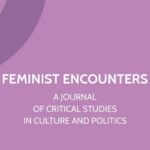 Feminist Encounters. A Journal of Critical Studies in Culture and Politics; Editors: Radhika Gajjala Maitrayee Basu, and Ololade Faniyi (Web)
Feminist Encounters. A Journal of Critical Studies in Culture and Politics; Editors: Radhika Gajjala Maitrayee Basu, and Ololade Faniyi (Web)
Proposals by: 30.06.202
In the past two decades, there has been a great deal of visibility for marginalised populations from many parts of the world via social media platforms – whether through Twitter, Facebook, Instagram, TikTok, Tumblr, YouTube, and other platforms. We have seen protest movements focused on gender, race and caste issues, for instance, utilising these privately-owned communication technology infrastructures to build networks, reach global audiences, and demonstrate the influence of digital „publics,“ „contrapublics,“ „alternetworks,“ „counterpublics,“ and so on. At the same time, these platforms are equally accessible to trolls and groups that use them to spread hate speech, fake news, propaganda, misinformation, and divisive rhetoric in the name of freedom of speech. Misogyny and cooptation of feminist languages of choice happens side-by-side with brand-feminisms and feminist activist callouts. Oppressive governments also use social media surveillance to silence dissent, enforce bans, and suppress opposition voices.
In this seemingly chaotic digital space, activists, influencers, and advocates attempt to simultaneously speak to their local, regional, national audiences while broadcasting outwards transnationally to garner solidarity and support. These outcries, callouts, and protests in digital publics create nuanced awareness around the particularities of social inequalities in the regions from which they originate. Therefore, the editors invite submissions that examine the cultural and political contexts of digital activism and how they shape practices, strategies, and considerations of activism and online engagement.
The editors welcome papers that nuance intersectionality as theory or method and those that deploy situated, contextual, intersectionalities to flesh out how activisms and solidarities can be forged based on shifting temporal, social, and geopolitical dynamics. They encourage Continue reading

 32. Internationalen Sommerakademie des Instituts für jüdische Geschichte, St. Pölten
32. Internationalen Sommerakademie des Instituts für jüdische Geschichte, St. Pölten ![Titelblatt aus Anton Zampis Erinnerungs-Bilder aus Wiens October-Tagen 1848, Wien [1850]. D-50142, Wienbibliothek im Rathaus - via Website](https://salon21.univie.ac.at/wp-content/uploads/2023/06/D-50142-2-150x150.jpg) Wienbibliothek im Rathaus
Wienbibliothek im Rathaus  Volkskundemuseum Wien; Kuratorinnen: Kathrin Pallestrang, Magdalena Puchberger und Maria Raid
Volkskundemuseum Wien; Kuratorinnen: Kathrin Pallestrang, Magdalena Puchberger und Maria Raid